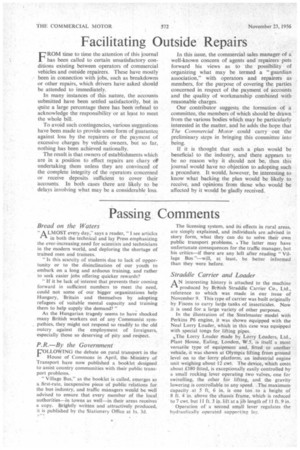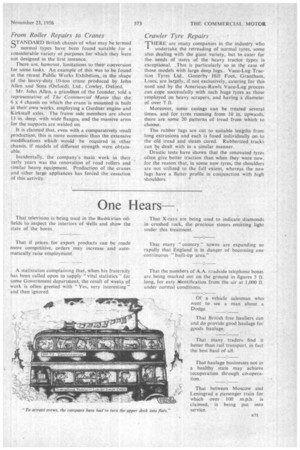Passing Comments•
Page 38

Page 39

If you've noticed an error in this article please click here to report it so we can fix it.
Bread on the Waters
'ALMOST every day," says a reader, I see articles 4-1 in both the technical and lay Press emphasizing the ever-increasing need for scientists and technicians in the modern world, and deploring the shortage of trained men and trainees.
"Is this scarcity of students due to lack of opportunity or to the disinclination of our youth to embark on a long and arduous training, and rather to seek easier jobs offering quicker rewards?
If it be lack of interest that prevents their coming forward in sufficient numbers to meet the need, could not some of our bigger organizations help Hungary, Britain and themselves by adopting refugees of suitable mental capacity and training them to help supply the demand?"
As the Hungarian tragedy seems to have shocked many British workers out of any Communist sympathies, they might not respond so readily to the old outcry against the employment of foreigners, especially those so deserving of pity and respect.
P.R.—By the Government FOLLOWING the debate on rural transport in the House of Commons in April, the Ministry of Transport have now published a booklet designed to assist country eommunities with their public transport problems.
"Village Bus," as the booklet is called, emerges as a first-rate, inexpensive* piece of public relations for the bus industry, and traffic managers would be well advised to ensure that every member of the local authorities—in towns as well—in their areas receives a copy. Brightly written and attractively produced, it is published by the Stationery Office at Is. 3d. The licensing system, and its effects in rural areas, are simply explained, and individuals are advised in story form, what they can do to solve their own public transport problems. . The latter may have unfortunate consequences for the traffic manager, but his critics—if there are any left after reading " Village Bus "—will, at least, be better informed than they were before.
Straddle Carrier and Loader
AN interesting history is attached to the machine
produced by British Straddle Carrier Co.., Ltd., reference to which was made in our issue of November 9. This type of carrier was built originally by Fisons to carry large tanks of insecticides. Now it is used for a large variety of other purposes.
In the illustration of the Steelmaster model with Perkins P6 engine, it was shown equipped with the Neal Lorry Loader, which in this case was equipped with special tongs for lifting pipes.
,,The Lorry Loader made by Lorry Loaders, Ltd., Plant House, Ealing, London, W.5, is itself a most versatile type of equipment and, fitted, to another vehicle, it was shown at Olympia lifting from ground level on to the lorry platform, an industrial engine unit weighing about 12 cwt. The device, which costs about £380 fitted, is exceptionally easily controlled by. a small rocking lever operating two valves, one for swivelling, the other for lifting, and the gravity lowering is controllable to any speed. The. maximum capacity -at 5 ft, 6 in. is one ton to a height of 8 ft. 4 in, above the chassis frame, which is reduced to 7 cwt. but 11 ft. 3 in. lift at a jib length of II ft. 9 in.
Operation of a second small lever regulates the hydraulically operated supporting leg.
From Roller Repairs to Cranes
QTANDARD British chassis of what may be termed normal types have been found suitable for a considerable variety of purposes for Which they were not designed in thc first instance.
There are, however, limitations to their conversion for some tasks. An example of this was to be found at the recent Public Works Exhibition, in the shape of the heavy-duty 10-ton crane produced by John Allen and Sons (Oxford), Ltd., Cowley, Oxford.
Mr. John Allen, a grandson of the founder, told a representative of The Commercial Motor that the 6 x 4 chassis on which the crane is mounted is built at their own works, employing a Gardner engine and Kirkstall axles. The frame side members are about 13 in. deep, with wide flanges, and the massive arms for the supports are welded on.
It is claimed that, even with a comparatively small production, this is more economic than the extensive modifications which would be required in other chassis, if models of different strength were obtainable.
Incidentally, the company's main work in their early years was the renovation of road rollers and similar heavy equipment. Production of the cranes and other large appliances has forced the cessation Of this activity.
Crawler Tyre Repairs
THERE are many companies in the industry who I undertake the retreading of normal tyres, some also dealing with the giant variety, but to cater for theneeds of users of the heavy tractor types is exceptional. ,This is particularly so in the case of those models with large deep lugs. Vacu-Lug Traction Tyres Ltd., Gonerby Hill Foot, Grantham, Lines, are largely, if not exclusively, catering for this need and by the American-Rawls Vacu-Lug process can cope successfully with such huge tyres as those employed on heavy scrapers, and having a diameter of over 7 ft.
Moreover, some casings can be treated several times, and for tyres running from 10 in. upwards, there are some 20 patterns of tread from which to choose.
The rubber lugs are cut to suitable lengths from long extrusions and each is fused individually on to the old tread and steam cured. Rubberized tracks can be dealt with in a similar manner.
Drastic tests have shown that the renovated tyres often give better traction than when they were new, for the reason that, in some new tyres, the shoulders are not utilized to the full extent, whereas the new lugs have a flatter profile in conjunction with high shoulders. •
















































































































